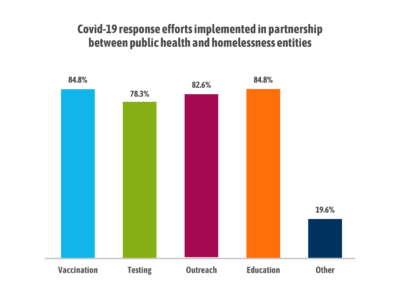Last month, the National Academy of Public Administration (NAPA) released a report examining the intergovernmental dimensions of homelessness. Describing homelessness as “inherently intergovernmental,” the report emphasizes that all levels of government (city, county, district, region, state, federal) must work alongside non-governmental entities (nonprofits, businesses, residents, people experiencing homelessness) to efficiently and durably reduce homelessness.
As described by the authors, this report is intended for service providers, public administrators, nonprofit leaders, government employees, and others interested in reducing homelessness.
Members of the working group conducted interviews with experts and practitioners across the United States, read literature, and spoke with leaders in three places that have demonstrated success in reducing homelessness.
Much of the report resonates with techniques integral to Community Solutions’ Theory of Change regarding homelessness. Read on to uncover this report’s key findings and how they affirm Community Solutions’ collaborative, data-driven approach to solving homelessness.
Key Findings
One size does not fit all
Differences in homelessness trends and intergovernmental systems require solutions that are implemented place by place. Often spearheaded by local leaders, effective solutions start with basic techniques and evidence-based practices, but tailor them to their community.
One critical starting point is often a “Housing First” approach. Housing First models — central to Community Solutions programming — stress that helping move those experiencing homelessness into stable housing must come before providing other services.
Five basic tasks
Next, the report finds successful communities address five core tasks. These tasks are non-sequential and mutually reinforcing — for example, making progress on collecting data (Task 4) can make it easier to define one’s goals (Task 1).
1. Shared Goals and Strategies
Governmental and non-governmental organizations must come to a shared understanding about the nature of homelessness in their area. Successful communities usually adopt one homelessness definition, set long-term goals and near-term targets, and agree on initial strategies. Local leaders, Continuum of Care organizations, and knowledge held in the community all play important roles in goal/strategy development.
Community Solutions uses the concept of functional zero — a state in which homelessness is measurably rare and brief — to unite efforts across regional partners. By linking an agreed-upon goal to achievable milestones, several Built for Zero communities have shown it is possible to measurably reduce homelessness.
2. Organizational Networks
As homelessness crosses geographic, governmental, and functional boundaries, so too must responses. Successful communities build resilient and adaptable networks that span functions (e.g., health care, housing, employment) and jurisdictions (e.g., city, county, state, federal).
Building capacity is best achieved when there is (1) initiative from a neutral, trusted party with resources, (2) early participation from those with expertise and authority, (3) trust among participants, and (4) tools that facilitate action.
Community Solutions serves as an effective catalyst to network-building by leveraging its resources, expertise, and knowledge to generate trust among partners and develop new tools (e.g., by-name data).
3. Integrated Services
As networks evolve and grow, integrating services, eliminating redundancies, and simplifying the delivery process reduces costs and ensures more seamless user experiences.
Although the report emphasizes there is no standard model, integration should occur horizontally and vertically. Horizontal integration reduces administrative barriers by consolidating how and where services are received (employment, housing, health care). Vertical integration describes the extent to which local actors effectively engage with state/national entities. Both horizontal and vertical integration is foundational to Community Solutions’ Theory of Change, evidenced by this report’s direct reference to it.
4. High-Quality Data
High-quality data on homelessness trends, housing supply, employment rates, and other dynamics is another cornerstone to successful response systems. Community Solutions helps communities build their data infrastructure and technical capacity while emphasizing the procurement of “by-name data” on individuals experiencing homelessness.
Robust data analysis can uncover and correct service inefficiencies and inequities. Reporting data out can increase trust, improve buy-in, affect local attitudes, and bolster efforts to raise funds. As noted in research and affirmed in this report, Community Solutions supports the use of data to improve homelessness responses.
5. Sustainable Governing and Funding Structures
Finally, creating sustainable governing and funding structures is critical. Local dollars are rarely sufficient, so securing stable, long-term funding from a variety of governmental and non-governmental sources helps make sure homelessness response structures persist. Overcoming conflicting requirements for funding streams and developing agreement on cost sharing is difficult, but can be made easier with clear goals (Task 1) and high-quality data (Task 4), both domains that Community Solutions emphasizes in their programming.
Conclusions
Although homeless response systems are necessarily context dependent, this report reveals that shared goals, broad organizations, integrated services, high-quality data, and sustainable funding structures can better position communities to measurably reduce homelessness. Community Solutions will continue to serve as a critical coordinating institution to better position communities to overcome the intergovernmental challenges homelessness presents.




